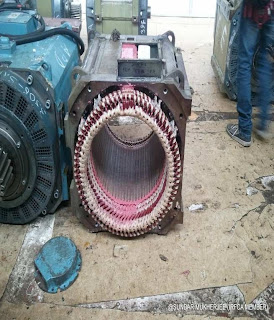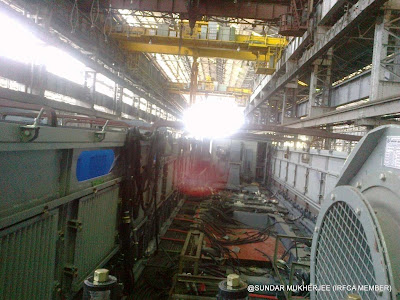CHITTARANJAN LOCOMOTIVE WORKS
Trip
report presented By:-
Acknowledgement :-
My
trip, my learning experience, my
understanding of the locomotives, my easy access to all
the workshops, and my innumerable questions being answered and explained to, has all
been possible
because of the kind help and encouragement of Mr Suresh Kumar, DyCEE,
D&D, CRJ.
Thank You sir, Thank you very much.
I am ever grateful to you.
With Regards
On top of the world. 15 Days in the world’s largest LocomOtive
factory: chittaranjan Locomotive works
It all started on 1st
april which was my 1st visit to CLW. 2 hours didn’t satisfy my
thirst at CLW. So I made a plan that I will visit CLW once again and this time
I would make sure that all my queries were responded to.
07-07-2013
:- Early morning boarded the Black Diamond Express with a friend of mine, Sony
Sengupta. The Loco was a HWH P7 30322.
Reached Asansol and
boarded a car to Rupnarayanpur. Rupnarayanpur(RNPR) is the station just before
Chittaranjan. Rented a hotel out there.
08-07-2013
:- Took a bus from Rupnarayanpur to Chittaranjan. The bus entered from GATE NO
3. A boarding sign read “WELCOME TO CHITTARANJAN LOCOMOTIVE WORKS.
STOP PLEASE SHOW YOUR PERMIT”.
Got down at Children’s
park just adjacent to Loco Park. Took an auto to the Design and Development
office. Fixed up an appointment with Mr
Suresh Kumar, Dy CEE, D&D, CRJ, an alumnus of IIT Kanpur. He
welcomed me.
Dy CEE D&D (CRJ)
Mr Suresh Kumar
I had already met him and got myself
introduced to him during my last visit to CLW. He issued us a Gate Pass valid
till 22.07.2013. We met the Senior
RPF to get our gate pass. Our names along with our photographs were stamped on
the Gate Pass.
Gate Pass
09-07-2013 :- Entered the factory through the
D&D gate.
Two huge workshops ELF 16 and ELB 14 also known as FABRICATION
SHOP the largest and longest at CLW was our entry point. As we moved we
could see the entire process where iron sheets are made, polished and were
being shifted from one shop to the other. Then we came across bogies of WAG 9
and WAP 5 being made and moulded into shapes. Huge Lathe machines were kept and
huge cranes more than 6 in number moved
to and fro shifting steel and bogies. Then we came across the huge metal sheets
where the entire Locomotive rests. We found the Cabs of G9, G7 kept at various
places. More than 5-6 Locomotives of various types were
in the construction process. Welding was done on a large scale basis.
As we moved through a swarm of locomotives we came
across a P7 being manufactured which was unique. It was the 2nd HOG
Loco P7 30365.
The Construction was in progress. Finally our trip to this workshop came to an
end. The total length of the workshop is 3.5kms. The day ended there.
10-07-2013
:- We entered the factory through the
Works Office gate. Moved downstairs to the next shop The Assembly Shop which is a few meters apart from the
Fabrication shop.
The Loco’s are send
here after Fabrication and Painting. The pipes,
transformers, electric connexions and complete overhauling of the loco is done
here before being send to the Testing
Shop. More than 25 Locos comprising of P4, P7, G7, G9 and P5 were kept there.
The equipments of
auxillary part I and II and switches of 3 Phase Loco’s were being assembled.
The connector pipes were being installed. Fitting of three phase and single
phase transformer was being done at the assembly shop.
It took a day for us to
see the whole process.
11-07-2013
:- The Traction Motor Shop.
The Most Interesting and the back bone of the 3 phase powerful monsters. More
than 50 stators were kept lying along with its rotor. Its none other than the
asynchronous squirrel cage induction motor. The complete process of making of
the huge machines is done by the mechanics/engineers in the TM shop.
The TM shop is divided
into various parts. In one room the winding is done by copper wires. In another
room expansion of the winding is done. In the 3rd room heat
treatment is done to check if there is any fault with the stator or any other
equipment in the Traction Motor. With the help of a wooden ruler the coils gets
fitted inside the stator.

Finally after seeing and
trying to learn about the various parts of the TM shop we moved back to Design
and Development. Mr Suresh Kumar Dy
CEE D&D allotted me a schedule for the various days since it was not
possible to visit the whole factory in a single day.
12-07-2013
:- ELF
& ELB
Like all structural
elements for trains, it begins with raw metal plates. Tons of steel and iron is
used for designing the bogies. Months of fitting and tooling, and finally a
bogie is made. The ELF & ELB workshop makes bogies for P5, P7 and G9.
Machines from Japan and other countries are found in the workshop where fitting
and shaping of bogies is done in a large scale. It took us 3 hours to
understand the complete procedure taking place. We were provided helmets from
the Safety Section to make sure we protect ourselves from those massive
machines and huge cranes moving to and fro carrying iron sheets on top of us.
We saw the entire
procedure of bogie joining with the help of electric arc machines. Ultrasonic
sound detectors were being used to detect a crack in the bogie. We saw WAP 5 and WAG 9 bogies being made but with
no modifications. Only WAP 7 bogie has been modified.

15-07-2013
:- Loco Assembly Shop
A WAP 4 and a WAG 7
welcomed us.
We
moved to the single phase transformer section which is still being used in
conventional Locos. A supervisor explained the details of the single phase
transformer. It is being supplied by BOMBARDIER and BHEL.
Then we moved further.
There were several Locos in which the transformer was already fitted. We came
across 3 phase transformers used in P7, P5 and G9 Locos.
The supervisor told us
that there is a key component difference in a P7/P5 and G9 transformers. P7 and
P5 Locomotive transformer has the facility for Hotel Load Generation which a G9
transformer doesn’t have. This was the key difference.
Then we went around the
assembly shop and saw how workers were fitting the equipments in the
Locomotives without any flaw. At 11am we left the shop and again we attended
the shop the very next day to understand the other features.
16-07-2013
:- We entered a WAP 7 and a WAG 7 locomotive. The road number was not yet notified.
The workers explained us the technique how they fix and arrange pipes moving throughout
the locomotive. Then we proceeded to the Pneumatic Panel section that controls
the pantograph operations. Then we saw how workers were working and fitting the
SB1 and SB2 also known as filter cubicle used in three phase locos for control
operations.
Mr Pankaj Sen
explained to us in brief the working of capacitors inside the filter cubicle
and the use of smoothing reactors used in conventional locos. He also explained
the working of transformer in 3 phase locos along with its circuits.
17-07-2013
:- The
Traction Motor Shop
The T.M Shop lives for
just one thing - to build the muscles for these 3 phase locomotives. The first
thing that is required for the production of these motor is lots of copper. A
machine handles the job. Then expansion of the coils is made and then the coils
are moved from one room to the other.
The fully wrapped coils gets fitted into the
stator. It takes team work to pull,
place and align the coils into the shell.
It took three hours to
see fifty percent of the work being done, which was placing the coils in the
stator. After the completion of the
stator, it is send for heat treatment to find out any flaws.

18-07-2013
:- Now the stator has been dressed its time to meet its mate, the Rotor. Mr Suprobhat Ghosal explained to
us in details how the motor shop functions and then we moved where the rotors
were being made. We saw hundreds of DC Series Motors lying on the floor while
moving to the rotor shop. We were shown with the help of a crane and a dummy
how a rotor is made. It took us 1 hour to see the construction of a rotor. Then
we came back to see the DC Series motors. They are supplied by HITACHI and
BHEL. Production of DC Series motors will soon come to an end. P4 and G7
Locomotives will no longer be produced.
19-07-2013 :-
Steel Foundry
All the steel used in
CLW is produced here. It is the largest steel foundry in Asia. Raw steel is
made here and are transported to various shops inside the steel foundry. Some
of the shops are 1. Mould Shop, 2. Core Shop, etc. Various types of Sand is the
source of different types of production. The bogies of WAP 4 also known as “Flexicoil
Mark IV” bogie, and Center Buffer Coupling(CBC) couplers are produced in the
steel foundry.
Several Heat Treatment
plants are present inside the steel foundry to check the cracks and flaws of
the bogies and the CBC couplers and reshape them so that they can be reused.
Electric Arc Welding
process is used to melt the steel and transform it into its desired shape.
For testing and
research purposes, there is a Chemical Laboratory.
Steel Foundry also
reshapes and moulds used steel that can no longer be used and again makes it
suitable for commercial use.
Steel Foundry manufactures steel
castings generally complaint with grades IS-1030 and AAR-201. To meet the
requirements of different products, Steel Foundry had earlier been processing
eight different grades of metal. Steel Foundry has been successful in
rationalizing the same to five grades only without affecting any metallurgical,
chemical or physical properties. This has resulted in improvement in
productivity.
22-07-2013 :- Testing
Shop
Our Last Day at CLW. The Locomotives after
completion are brought here and are tested on a test track. We went inside a
WAG 9H locomotive to see the IGBT module. Now, Crompton Greaves is supplying
IGBT modules to all WAG 9 Locomotives. Earlier BOMBARDIER, BHEL and ABB had supplied
IGBT. The Loco was 31413. It was a WAG 9H. The only difference
between a WAG 9 and WAG 9H is an extra ballast installed in the machine room, resulting in an extra weight of 12 tons.
We also spotted few more Locomotives present
in the Testing Shop which would be dispatched soon.
A WAP 4 22968 with MU operation facility
given.
Few WAP 7’s. Among them
30360 was ready.
Few WAG 9’s, WAG 7, a
WAP 5 and few WAP 7.

Few trial runs were
also being done.


Finally we left the
factory at 11.30am. We reached Asansol station at 4:35pm.
Black Diamond Express arrived at Platform 5
with WAP 4 22303.
Note: Please refer GP 140 article's to know the entire history of 3 Phase Locomotives in India.
-----xxx-----






.jpg)






































.jpg)




.jpg)
.jpg)
.jpg)
.jpg)
0 comments:
Post a Comment